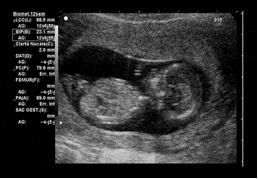Just What Are Nano-movements?–May 14, 2015
Just What Are Nano-movements?
Nanotechnology, Nanobiology, Nanoparticles…Nano-movements?
The prefix ‘Nano’ is a math term meaning one billionth, or .000000001, which is really small!
During the past year we’ve taken movement down to a whole new level—integrating the smallest observed movements with amazing results!
 Teeny-tiny movements have been systematically observed via ultrasound during prenatal development. Twenty years of sophisticated imaging techniques and analytical tools enabled observation and categorization of these early movements. The groundbreaking research is by Austrian’s Pretchl and Einspeiler. Their research documents the movement type and quality during pre-natal development phases. We developed the nano-movement terms which correlate to Prechtl’s observations.
Teeny-tiny movements have been systematically observed via ultrasound during prenatal development. Twenty years of sophisticated imaging techniques and analytical tools enabled observation and categorization of these early movements. The groundbreaking research is by Austrian’s Pretchl and Einspeiler. Their research documents the movement type and quality during pre-natal development phases. We developed the nano-movement terms which correlate to Prechtl’s observations.
These amazing insights are just like looking at pond water under a microscope—it’s a whole new world!
Modular Movement Foundation
Our most amazing insight about nano-movements is they yield very distinct patterns forming integral layers to sensorimotor development. You will hear us referencing PEANUT, BUBBLE, or BUG—our names for the first set of these earliest of movements. Over the next few weeks I’ll introduce you to each of these.
Below is the Learning Pyramid by Williams and Shellenberger (1996). Nano-movements weave the base layer together enabling so many vital life skills for all ages! When these nano-movements are not completely developed or have been impaired by injury, a person’s overall movement and sensory integration is compromised.
How Do We Assess Nano-movements?
Assessment is straightforward. We check to see if we can you passively move in a set of specific ways. The passive ability for your head/core/limbs to function together is indicative of the maturity of the nano-movements.
Why Would I Not Have a Nano-movement?
There are two scenarios for gaps in nano-movements—developmental and injury/illness. The primary sources of developmental gaps are genetic and/or related to unusual stress in the first trimester.
Injury and illness can also throw off your nano-movements. The most common have been head injuries, pregnancy, auto-accidents, and surgical procedures in the chest or abdomen including minimally-invasive ones.
Can I Still Learn a Nano-movement?
The only time you were able to learn these on your own was when you were a twinkle in your parents eyes! Your muscles progressed to develop compensatory layers of movement to allow you to actually function. We are able to isolate out the specific groups of muscles used for the nano-movements, give them a little tutoring on the sidelines, and let them jump back into the game of life. Often there is a bit of untangling the layers of compensations before being able to restore nano-movements.
We use the passive stretch-based Bridging® Technique to teach your muscles the new ways of working together. Generally, it’s a fairly quick process of a few sessions to restore the basics. What amazes clients is how subtle and gentle the movements are. In some cases, it seems like we simply give your muscles some dots to connect like two magnets making a connection.
Is It Too Late to Learn Nano-movements?
It’s never too late! We work with ages 0 to 92+ and have great success in restoring these essential movements.
From infants to adults, we restore your nano- and micro-movements quickly returning you to the movements that define your life!
Note from Cara
This month I’m going technical on you! My background is engineering and I love to delve into details.
My journey of improving movement, coordination, and balance led me to an unusual place—the earliest weeks of development, where details abound! These tiny movements end up being an essential ingredient to all the big movements used for sports and life.
Enjoy the warmer days, and let us know if your nano-movements need a tune-up before summer.

